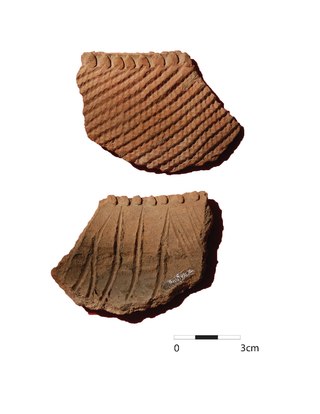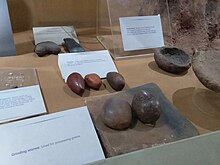Hyrax Hill is a prehistoric site near Nakuru in the Rift Valley province of Kenya. It is a rocky spur roughly half a kilometer in length, with an elevation of 1,900 meters above sea level at its summit. The site was first discovered in 1926 by Louis Leakey during excavations at the nearby Nakuru Burial Site, and Mary Leakey conducted the first major excavations between 1937 and 1938. There are two distinct areas of occupation at Hyrax Hill: one which was occupied during the Pastoral Neolithic and late Iron Age, and one which was occupied by the Sirikwa earlier in the Iron Age.

The Urewe culture developed and spread in and around the Lake Victoria region of Africa during the African Iron Age. The culture's earliest dated artefacts are located in the Kagera Region of Tanzania, and it extended as far west as the Kivu region of the Democratic Republic of the Congo, as far east as the Nyanza and Western provinces of Kenya, and north into Uganda, Rwanda and Burundi. Sites from the Urewe culture date from the Early Iron Age, from the 5th century BC to the 6th century AD. The Urewe people certainly did not disappear, and the continuity of institutional life was never completely broken. One of the most striking things about the Early Iron Age pots and smelting furnaces is that some of them were discovered at sites that the local people still associate with royalty, and still more significant is the continuity of language.
Enkapune Ya Muto, also known as Twilight Cave, is a site spanning the late Middle Stone Age to the Late Stone Age on the Mau Escarpment of Kenya. This time span has allowed for further study of the transition from the Middle Stone Age to the Late Stone Age. In particular, the changes in lithic and pottery industries can be tracked over these time periods as well as transitions from a hunter-gatherer lifestyle to a herding lifestyle. Beads made of perforated ostrich egg shells found at the site have been dated to 40,000 years ago. The beads found at the site represent the early human use of personal ornaments. Inferences pertaining to climate and environment changes during the pre-Holocene and Holocene period have been made based from faunal remains based in this site.
Ngenyn is a Late Stone Age and/or a Savanna Pastoral Neolithic archaeological site located in the Kapthurin River Basin, which is part of the Tugen Hills, west of Lake Baringo. It falls within the Baringo County in north central Kenya. The occupied area is situated on the floodplain of the River Ndau's confluence with the Sekutionnen River, on a widespread terrace called the Low Terrace, the top of which is about 3m above the level of the modern river. The site was initially discovered by Louis Leakey in 1969. It was visible as a large exposure of bones, stone tools and pottery eroding out of the terrace. The site was excavated in the late 1970s as part of Francoise Hivernel's PhD research. Ngenyn remains the only Late Holocene site excavated in the Lake Baringo Basin and in general very little archaeological work has been done on the Late Holocene within the Baringo County.
The Kalenjin people are an ethnolinguistic group indigenous to East Africa, with a presence, as dated by archaeology and linguistics, that goes back many centuries. Their history is therefore deeply interwoven with those of their neighboring communities as well as with the histories of Kenya, Uganda, Tanzania, South Sudan, and Ethiopia.

The Savanna Pastoral Neolithic is a collection of ancient societies that appeared in the Rift Valley of East Africa and surrounding areas during a time period known as the Pastoral Neolithic. They were South Cushitic speaking pastoralists who tended to bury their dead in cairns, whilst their toolkit was characterized by stone bowls, pestles, grindstones and earthenware pots.

The Pastoral Neolithic refers to a period in Africa's prehistory, specifically Tanzania and Kenya, marking the beginning of food production, livestock domestication, and pottery use in the region following the Later Stone Age. The exact dates of this time period remain inexact, but early Pastoral Neolithic sites support the beginning of herding by 5000 BP. In contrast to the Neolithic in other parts of the world, which saw the development of farming societies, the first form of African food production was nomadic pastoralism, or ways of life centered on the herding and management of livestock. The shift from hunting to food production relied on livestock that had been domesticated outside of East Africa, especially North Africa. This period marks the emergence of the forms of pastoralism that are still present. The reliance on livestock herding marks the deviation from hunting-gathering but precedes major agricultural development. The exact movement tendencies of Neolithic pastoralists are not completely understood.
Ngamuriak is an archaeological site located in south-western Kenya. It has been interpreted as an Elmenteitan Pastoral Neolithic settlement. The excavation of this site produced pottery sherds, stone tools with obsidian fragments and obsidian blades, along with large amounts of animal bones.
To understand past cultures archaeologists analyze many artifacts. Pottery proves to be of most importance to the archaeological record. Pottery is durable and even allows its broken fragments to withstand time, which would otherwise decompose other artifacts. More importantly, the style of pottery often changes through time, and shifts in shape, size, or decoration can be used to resolve the age of the artifact and/or site. Furthermore, though pottery is common, different cultures had their own distinct styles that can be used to determine its similarities or differences with one another. Therefore, even fragments of pottery can reconstruct many facets of past cultures.
Gogo Falls is an archaeological site near a former and since 1956 dammed waterfall, located in the Lake Victoria Basin in Migori County, western Kenya. This site is important to archaeology as it includes some of the earliest appearances of artifacts and domestic animals in the area. The findings at the site help to reconstruct the later prehistory around Lake Victoria, including a Pastoral Neolithic occupation by Elmenteitan peoples and a later Iron Age occupation. Artifacts found at the site included pottery and iron artifacts. Through these artifacts some of the cultural traditions of the people who lived near Gogo Falls were discovered.
Njoro River Cave is an archaeological site on the Mau Escarpment, Kenya, that was first excavated in 1938 by Mary Leakey and her husband Louis Leakey. Excavations revealed a mass cremation site created by Elmenteitan pastoralists during the Pastoral Neolithic roughly 3350-3050 BP. Excavations also uncovered pottery, beads, stone bowls, basket work, pestles and flakes. The Leakeys' excavation was one of the earliest to uncover ancient beads and tools in the area and a later investigation in 1950 was the first to use radiocarbon dating in East Africa.

People first began to be interested in Malawi's prehistoric past in the 1920s. Excavations of sites in nearby countries, Tanzania and Zambia, made archaeologists believe that they may find the same type of material culture in Malawi. In the 1920s, a series of lacustrine deposits was found at the northwest end of Lake Malawi. These beds contained fragmentary fossils and were mapped by Dr. F. Dixey. These findings sparked an interest to excavate more locations in Malawi.
Luxmanda is an archaeological site located in the north-central Babati District of Tanzania. It was discovered in 2012. Excavations in the area have identified it as the largest and southernmost settlement site of the Savanna Pastoral Neolithic (SPN), an archaeologically-recognized pastoralist culture centered in eastern Africa during a time period known as the Pastoral Neolithic. Radiocarbon dating of charcoal, human collagen, and organic matter in ceramic artifacts indicate that Luxmanda was occupied between 3,200 to 2,900 years ago. Ceramics, lithics, worked bone, ivory, and ostrich eggshell assemblages in addition to livestock and human bones have been recovered from the Luxmanda site. Large grinding stones have also been found, though their function remains uncertain. The people of Luxmanda were highly specialized pastoralists, relying on cattle, sheep, goats, and donkeys for subsistence. Their linguistic affiliation is unknown, but some historical linguists have speculated that the peoples of the SPN spoke Cushitic languages. The Pastoral Neolithic was followed by the Pastoral Iron Age and the Bantu Expansion.

The Sirikwa culture was the predominant Kenyan hinterland culture of the Pastoral Iron Age, c.2000 BP. Seen to have developed out of the Elmenteitan culture of the East African Pastoral Neolithic c.3300-1200 BP, it was followed in much of its area by the Kalenjin, Maa, western and central Kenyan communities of the 18th and 19th centuries.

The Lothagam North Pillar Site, registered as GeJi9, is an archaeological site at Lothagam on the west side of Lake Turkana in Kenya dating to the Pastoral Neolithic and the Holocene. It is a communal cemetery, built between 3000 BCE and 2300 BCE by the region's earliest herders as rainfall in the area decreased and Lake Turkana receded. It is thought to be eastern Africa's largest and earliest monumental cemetery.
Nasera Rockshelter is an archaeological site located in the Ngorongoro Conservation Area within Ngorongoro District of Arusha Region in northern Tanzania, and it has evidence of Middle Stone Age and Later Stone Age occupations in the Late Pleistocene to early Holocene, and ceramic-bearing Holocene occupations attributed to Kansyore, Nderit, and Savanna Pastoral Neolithic traditions. It was first excavated by Louis Leakey in 1932. A second series of excavations by Michael Mehlman in 1975 and 1976 led to the first comprehensive published study of the shelter, its stratigraphy and chronology, and its abundant material culture, including stone tools, faunal remains, and pottery. Recent work has sought to better understand chronology, lithic technology, mobility and demography, and site formation processes at Nasera Rockshelter. Nasera Rockshelter is considered a key site in eastern Africa for understanding the Middle Stone Age to Later Stone Age transition, and also for the study of the spread of livestock herding during the Pastoral Neolithic. Its chronology and archaeological sequence have been compared to those of other key sites in the region such as Mumba Rockshelter, Kisese II Rockshelter, Panga ya Saidi, and Enkapune ya Muto.

Nderit pottery is a type of ceramic vessel found at archaeological sites in Africa, particularly Tanzania and Kenya. Nderit pottery, previously known as ceramic tradition "Gumban A ware," was initially documented by Louis Leakey in the 1930s at sites in the Central Rift Valley of Kenya.Stylistic characteristics of Nderit pottery discovered in the Central Rift Valley include an exterior decoration of basket-like and triangular markings into the clay’s surface. The vessels here also have intensely scored interiors that do not appear to follow a distinct pattern. Nderit Ware exemplifies the transition from Saharan wavy-line early Holocene pottery towards the basket-like designs of the middle Holocene. Lipid residue found on Nderit pottery can be used to analyze the food products stored in them by early pastoralist societies.
Prospect Farm is an archaeological site on the northern side of Mt. Eburru that has been known to show evidence of prehistoric inhabitants. Excavations have uncovered tool-based artifacts that date to the Middle Stone Age, Later Stone Age, and Pastoral Neolithic that were recognized to be a unique Prospect Industry style. Additionally, bowls were found of the Savanna Pastoral Neolithic. With the large amounts of artifacts found, current work lies in using forms of dating like radiocarbon dating and obsidian hydration to understand the specifics of when these artifacts originated, as well as when the land was used. Current research seeks to build upon this by trying to understand how inhabitants of the Prospect Farm interacted with other groups.

The prehistory of East Africa spans from the earliest human presence in the region until the emergence of the Iron Age in East Africa. Between 1,600,000 BP and 1,500,000 BP, the Homo ergaster known as Nariokotome Boy resided near Nariokotome River, Kenya. Modern humans, who left behind remains, resided at Omo Kibish in 233,000 BP. Afro-Asiatic speakers and Nilo-Saharan speakers expanded in East Africa, resulting in transformation of food systems of East Africa. Prehistoric West Africans may have diverged into distinct ancestral groups of modern West Africans and Bantu-speaking peoples in Cameroon, and, subsequently, around 5000 BP, the Bantu-speaking peoples migrated into other parts of Sub-Saharan Africa.
The Jarigole pillar site is one of the megalithic communal cemetery sites in Lake Turkana Basin in Northern Kenya associated with the Pastoral Neolithic period. The site is located on the eastern shores of Lake Turkana in the southeastern edge of the Sibiloi National Park. Situated in a recessional beach which is 70 meters above the 1973 lake level, the site includes oval platforms >1000 sq m with a circular mound, and 28 basalt pillars each weighing about 200 kg and moved over a distance of 2 km from the site. The site is believed to have been constructed by the first wave of ancient herders who migrated to the region down from the Sahara around 5000 years ago, a period marked by rapid climatic, economic and social change.











